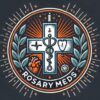Thursday, April 1 is the feast day of St. Mary of Egypt. I came across her story of forgiveness and redemption on EWTN News and thought I would share it with you since it ties in so nicely with many mysteries of the rosary. Mary of Egypt was born in 344 A.D. and worked as a prostitute for 17 years. She joined a pilgrimage to Jerusalem so that she could sell her services to those travelling to venerate the relic of the True Cross. Upon arriving at the church where she intended to lead many into sin, a mysterious force prevented her from entering with the other pilgrims. After trying several times she gave up, went into a small courtyard, and began to cry in remorse. Upon seeing a statue of the Virgin Mary, she prayed for permission to enter the church promising to give up her sinful ways. Mary granted her permission. Changed by the experience and touched by God’s mercy Mary of Egypt lived as a hermit in the desert for 47 years.
